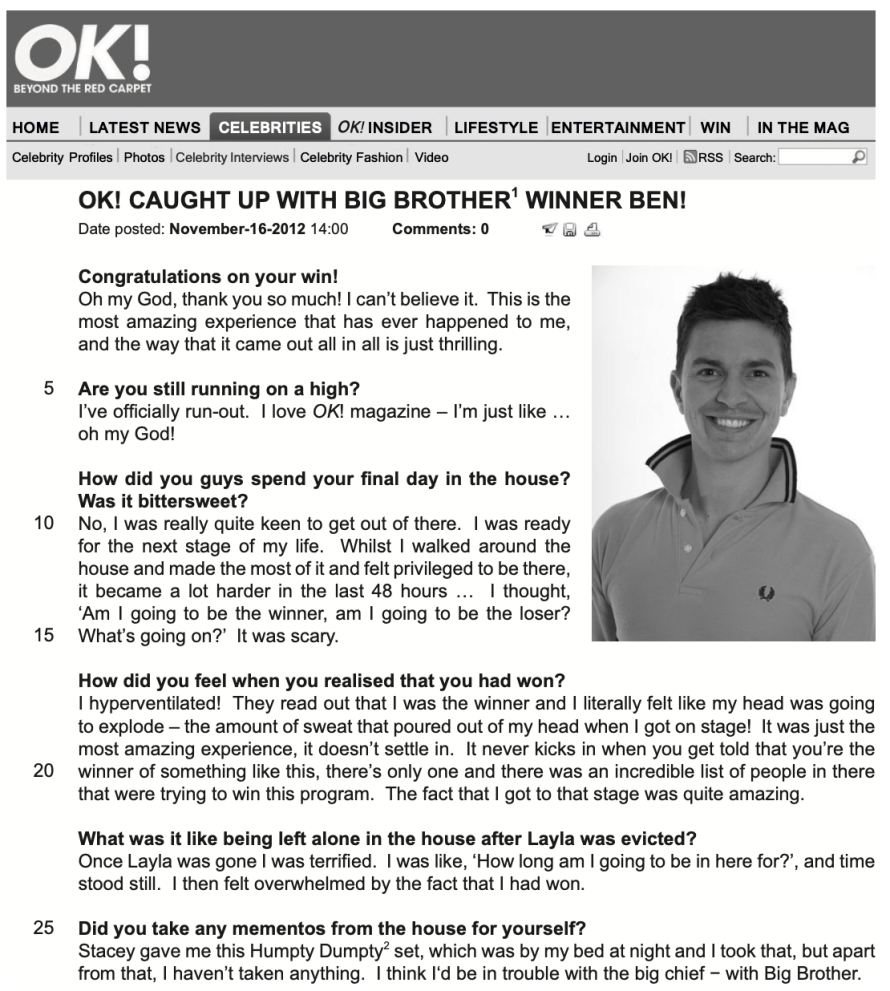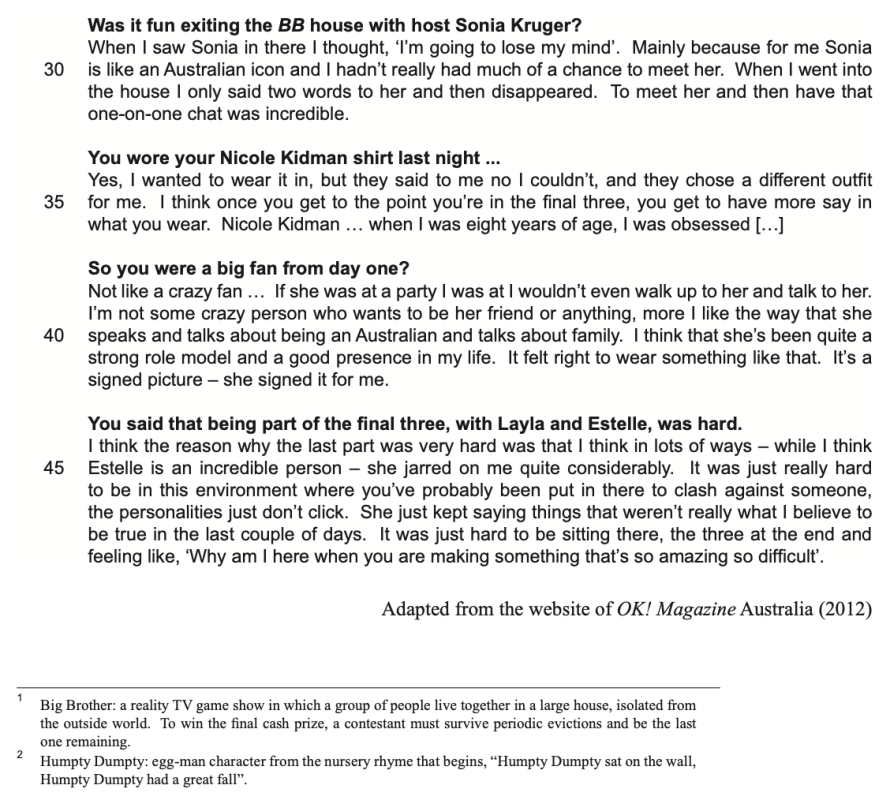Unseen Text: Big Brother Winner
Text Type: Tabloid Interview
Guiding Question: Analyse both the questions and the answers in this interview to show how Ben is presented and how he presents himself.
When preparing for Paper 1, you are encouraged to explore as many different text types as possible; nevertheless, it’s impossible to predict what might come up in your exam. The Lang and Lit subject guide states explicitly that you are not meant to try to memorise features of every text type. Instead you should transfer your learning from one part of the course to another where you can. The response below demonstrates this transfer of learning. It focuses on the way the text creates a ‘them-and-us’ divide between ordinary people and celebrities, and explains how ‘name-calling’ contributes to this effect, two features that you may have encountered elsewhere. Of course, this is not the only way to respond to this text and you may have alternative ideas that can be equally valid.


Sample Response:
This text is an article from the website of OK! Magazine. From the masthead, banner and tabs it can be seen that OK! is devoted to celebrity news and articles. The word ‘celebrity’ is repeated four times in the banner alone, and the slogans ‘Beyond the Red Carpet’ and ‘OK! Insider’ promise the reader will discover secrets or surprises that only OK! can divulge. While the website is able to reach a mass audience of anybody who has access to the internet, the readership is likely to be niche: people who follow celebrity culture. The website plays upon the appeal of gossip; avid readers want to uncover gossip about celebrity lives that they can share in their own social circles. In addition, this article is about the winner of an Australian reality TV show, so the article would have more relevance to an Australian reader.
This interview fulfils the website’s stated purpose of getting ‘insider’ information about television celebrities. The person being interviewed is Ben, who recently won Big Brother, a reality TV show competition involving a group of people living together in a house with no access to the outside world. Each week, a member of the group is voted out by the TV audience until only one is left – the winner. Because he won, Ben was the final participant on the show and able to ‘exit the house with Sonia Kruger’, the host and television celebrity in her own right. In effect, he was granted access to the celebrity world, which is normally ‘off-limits’ to people like Ben. Overall, the text follows a trend in the mass media of putting celebrities on a pedestal and creating a ‘them-and-us’ divide between celebrities and ‘ordinary’ people, such as the contestants on the show. This divide is mirrored in the format of the interview, question-and-answer, with the questions presented in bold type and the answers in regular type, a visual representation of the two worlds of celebrity and ‘everyone else.’
Therefore, the interviewer’s questions attempt to uncover how Ben’s experience was ‘special’ and lead Ben to answer in a way that suggests access to the celebrity world is an extraordinary event. He uses words like ‘thrilling’, ‘scary’ and ‘terrified’ to describe the emotional intensity of his experience. His responses involve hyperbole and superlative, especially when he says, ‘This was the most amazing experience.’ He uses the word ‘overwhelmed’ and, at certain points, he just says, ‘Oh my god,’ as if words cannot describe the experience of rubbing shoulders with the rich and famous. He also employs figurative language to describe the moment that he discovered he would be the winner of the competition; ‘I felt like my head was going to explode’ and ‘time stood still.’ All in all, the reader is left in no doubt that being in the celebrity world is an intense experience, almost magical and completely ‘out-of-the-ordinary.’
In this way, Ben’s answers reveal the difference between an ‘ordinary’ person and a celebrity. He admits that ‘I felt privileged to be there’. The interviewer is happy to develop this line of thought later in the interview. She mentions his association with Sonia Kruger, the host of the show. Ben describes her as an ‘icon,’ a word which means ‘to look up to’ or even ‘worship.’ He speaks about meeting a celebrity in person in tones of gratitude, saying that ‘to meet her and then have that one-on-one chat was incredible.’ Once again, his use of hyperbole (‘incredible’) and figurative language (‘lose my mind’) suggests a difference between a celebrity and a ‘normal’ person. The magazine controls Ben’s position through the photo of him as well; he’s presented against a plain background, wearing a simple t-shirt with the collar turned up, as if he’s ordinary. Despite winning the show, he has not attained true celebrity status so has to remain ‘on the ground’ looking up at his idols.
It is undoubtedly in the magazine’s interest to foster a celebrity obsession amongst its readers, which might explain the focus on Ben’s Nicole Kidman t-shirt. Ben’s use of the word ‘obsession’ plays into the interviewer’s hands in this regard, and she immediately asks another question about being a ‘big fan’. Perhaps aware of the way he is presenting himself, Ben backtracks slightly and makes the point that he’s ‘not like a crazy fan.’ He actually repeats this to ensure that the readers view his type of celebrity worship as ‘healthy.’ He emphasises the positive aspects of his Nicole Kidman celebrity-crush using words like ‘family’, ‘strong role model’ and ‘good presence.’ He tries to control his own image by walking back the ‘big fan’ suggestion and presenting his wearing her image on his t-shirt as a kind of respectful tribute, but this too furthers the divide between him and a ‘real’ celebrity.
The final question reinforces the ‘them-and-us’ divide though naming conventions. The interviewer states, ‘you said that being part of the final three, with Layla and Estelle, was hard.’ It’s noticeable that, when speaking about famous celebrities, the interviewer uses full names (‘Sonia Kruger’ and ‘Nicole Kidman’) but when speaking about contestants on the show, uses only first names; ‘Ben’, ‘Layla’ and ‘Estelle’. The shift from formal to informal naming implies the interviewer ‘sees’ ordinary people and celebrities as different. Once again, it’s clear that the interviewer is able to lead Ben’s response by loading the question with a keyword, ‘hard’, as he repeats this word three times in his answer (and uses the word ‘difficult’, which means the same thing, at the end). Just like when talking about his hero-worship of Nicole Kidman, though, there is evidence that Ben is conscious of his own image here as well. He qualifies his criticisms of Estelle with the interjection ‘– while I think Estelle is an incredible person –’ perhaps afraid of coming across as too negative to readers of the interview.
In conclusion, this text is an excellent example of how an interviewer can set an agenda and control the response of the interviewee. It suits the interviewer’s purpose to hear Ben’s hyperbole and cliched answers about how ‘amazing’ and ‘incredible’ being part of a TV show can be. The interviewer then steers the interview towards meeting celebrities in person, as if this is an aspiration or a dream come true. It is at this point that Ben attempts to take back control of his own image, presenting himself as something more than an avid fanboy; but arguably the damage is already done. Despite being the winner of the show, he’s still on the wrong side of the celebrity divide.
Categories:Paper 1 Analysis